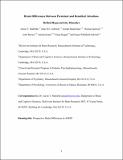| dc.contributor.author | Mattfeld, Aaron T. | |
| dc.contributor.author | Gabrieli, John D. E. | |
| dc.contributor.author | Biederman, Joseph | |
| dc.contributor.author | Spencer, Thomas | |
| dc.contributor.author | Brown, Ariel | |
| dc.contributor.author | Kotte, Amelia | |
| dc.contributor.author | Kagan, Elana | |
| dc.contributor.author | Gabrieli, Susan | |
| dc.date.accessioned | 2014-06-18T14:18:50Z | |
| dc.date.available | 2014-06-18T14:18:50Z | |
| dc.date.issued | 2014-06 | |
| dc.date.submitted | 2014-03 | |
| dc.identifier.issn | 0006-8950 | |
| dc.identifier.issn | 1460-2156 | |
| dc.identifier.uri | http://hdl.handle.net/1721.1/88027 | |
| dc.description.abstract | Previous resting state studies examining the brain basis of attention deficit hyperactivity disorder have not distinguished between patients who persist versus those who remit from the diagnosis as adults. To characterize the neurobiological differences and similarities of persistence and remittance, we performed resting state functional magnetic resonance imaging in individuals who had been longitudinally and uniformly characterized as having or not having attention deficit hyperactivity disorder in childhood and again in adulthood (16 years after baseline assessment). Intrinsic functional brain organization was measured in patients who had a persistent diagnosis in childhood and adulthood (n = 13), in patients who met diagnosis in childhood but not in adulthood (n = 22), and in control participants who never had attention deficit hyperactivity disorder (n = 17). A positive functional correlation between posterior cingulate and medial prefrontal cortices, major components of the default-mode network, was reduced only in patients whose diagnosis persisted into adulthood. A negative functional correlation between medial and dorsolateral prefrontal cortices was reduced in both persistent and remitted patients. The neurobiological dissociation between the persistence and remittance of attention deficit hyperactivity disorder may provide a framework for the relation between the clinical diagnosis, which indicates the need for treatment, and additional deficits that are common, such as executive dysfunctions. | en_US |
| dc.description.sponsorship | McGovern Institute for Brain Research at MIT (Poitras Center for Affective Disorders Research) | en_US |
| dc.description.sponsorship | Massachusetts General Hospital (Paediatric Psychopharmacology Council Fund) | en_US |
| dc.language.iso | en_US | |
| dc.publisher | Oxford University Press | en_US |
| dc.relation.isversionof | http://dx.doi.org/10.1093/brain/awu137 | en_US |
| dc.rights | Creative Commons Attribution-Noncommercial-Share Alike | en_US |
| dc.rights.uri | http://creativecommons.org/licenses/by-nc-sa/4.0/ | en_US |
| dc.source | Mattfeld | en_US |
| dc.title | Brain Differences Between Persistent and Remitted Attention-Deficit/Hyperactivity Disorder | en_US |
| dc.title.alternative | Brain differences between persistent and remitted attention deficit hyperactivity disorder | en_US |
| dc.type | Article | en_US |
| dc.identifier.citation | Mattfeld, A. T., J. D. E. Gabrieli, J. Biederman, T. Spencer, A. Brown, A. Kotte, E. Kagan, and S. Whitfield-Gabrieli. “Brain Differences Between Persistent and Remitted Attention Deficit Hyperactivity Disorder.” Brain (June 10, 2014). p.1-6. | en_US |
| dc.contributor.department | Massachusetts Institute of Technology. Department of Brain and Cognitive Sciences | en_US |
| dc.contributor.department | McGovern Institute for Brain Research at MIT | en_US |
| dc.contributor.approver | Gabrieli, John D. E. | en_US |
| dc.contributor.mitauthor | Gabrieli, John D. E. | en_US |
| dc.contributor.mitauthor | Gabrieli, Susan | en_US |
| dc.relation.journal | Brain | en_US |
| dc.eprint.version | Author's final manuscript | en_US |
| dc.type.uri | http://purl.org/eprint/type/JournalArticle | en_US |
| eprint.status | http://purl.org/eprint/status/PeerReviewed | en_US |
| dspace.orderedauthors | Mattfeld, A. T.; Gabrieli, J. D. E.; Biederman, J.; Spencer, T.; Brown, A.; Kotte, A.; Kagan, E.; Whitfield-Gabrieli, S. | en_US |
| dc.identifier.orcid | https://orcid.org/0000-0003-1158-5692 | |
| mit.license | OPEN_ACCESS_POLICY | en_US |
| mit.metadata.status | Complete | |
